A shared email account is a single shared email address, often something like support@ or help@, that is used by multiple members of a team or company to send and receive email from a central inbox.
While it's possible to create a team inbox by sharing the login credentials for a single email address with multiple team members, most teams opt to use a specialized tool that offers more advanced collaboration features. Using a dedicated tool is also a much more secure way of email sharing and allows a bit more control over team data.
Below, we’ll explore the various types of shared email accounts and offer nine tools to consider if you're looking to improve your team's ability to collaborate while sharing emails.
9 great tools for creating a shared email account
Although the following tools won’t automatically create a great customer experience, they can provide the structure and systems that allow your team to consistently improve your service.
1. Help Scout
Best shared inbox software for customer support.
As part of its all-in-one help desk software, Help Scout offers a shared inbox that's designed for customer support teams. Teams can automatically assign incoming emails using workflows, use saved replies to answer frequently asked questions, and avoid sending customers duplicate replies with collision detection.
Along with help team administration tools, Help Scout offers great email functionality at the conversation level. Team members can create shared email templates to resolve conversations even more quickly and thoroughly. This is great for knowledge sharing amongst team members, and it helps lower key business metrics like time to first response and first contact resolution.
Help Scout also offers pre-built performance reports and tags, helping teams better pinpoint why customers are reaching out, where the team is excelling, and where there are areas for improvement. Teams can also offer live chat support through Beacon or build out a knowledge base using Docs.
These features, along with mobile iOS and Android apps and 50+ third-party integrations, are included in all Help Scout plans, providing a real bang for your buck.
Price: Free plan available. Paid plans starting at $50 per month.
2. Outlook Shared Mailbox
Best shared mailbox for smaller teams already using Outlook.
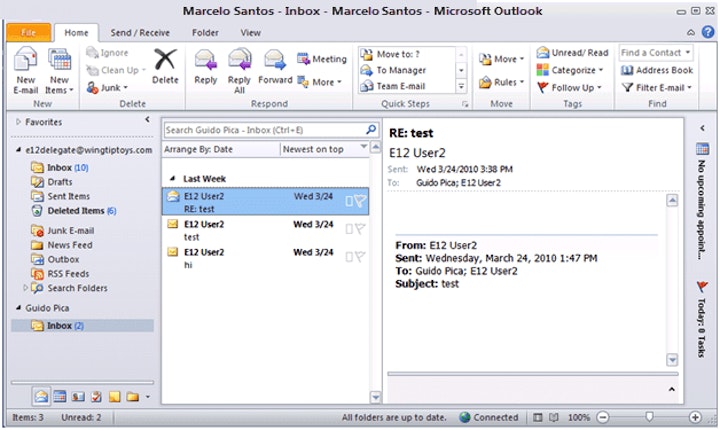
Outlook Shared Mailbox provides an effective basic shared mailbox if your team currently uses Microsoft Outlook. With it, you can create a group and then invite other members, giving them the ability to work from the same queue and assign emails.
However, because it isn’t a tool built specifically for customer service, it lacks features geared toward those needs.
Price: Free for current Outlook users.
3. Google Collaborative Inbox
Best shared mailbox for smaller teams using Google Workspace.

If your team is just starting out and already using Gmail, Google Collaborative Inbox is a good option. It’s free and allows teams to streamline some of the support processes while allowing multiple people to respond from the same email address without sharing their personal Gmail account login information, preventing security issues.
However, like Outlook, it’s not built specifically as a shared inbox tool, so there aren’t any additional features offered beyond what is available in Gmail already, which can hinder opportunities to scale.
Price: Free for current Google Workspace users.
4. Front
Best shared inbox for personal email use.

If your team wants to use both personal and shared professional email addresses to interact with customers, Front could be a great option.
Front helps teams of all types — support, marketing, and sales — manage communications with a personal touch. Still, you can’t use Front to utilize chat support or create a knowledge base, which can make scaling your support difficult.
Price: Starting at $19/person per month.
5. Hiver
Best shared mailbox for teams using Gmail that need additional collaboration features.
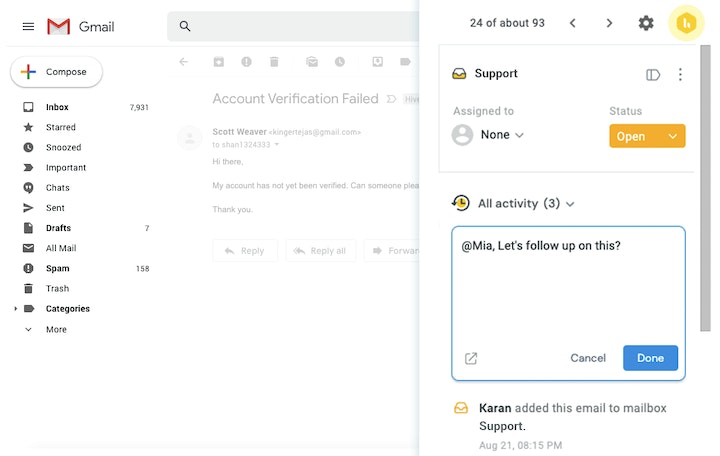
Another option for Gmail users is Hiver. Hiver is a Gmail inbox add-on that is geared toward customer support, allowing teams to assign emails to specific agents, add notes, and set up task automation and analytics.
However, while they do offer more support-centric features than Google Collaborative Inbox, many of the more advanced features like live chat, CSAT surveys, and knowledge base capabilities are only offered in the higher-cost tiers.
Price: Starting at $12/user per month.
6. Sortd
Best shared email account for project management through Gmail.
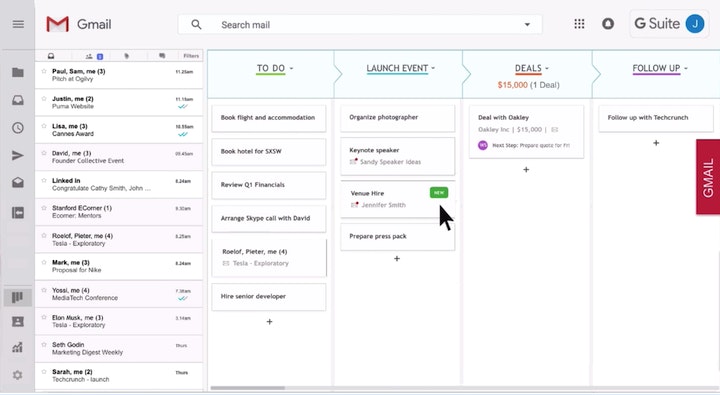
If your team is using Gmail as its email provider but is looking for a project management solution, Sortd could be a great option. With Sortd, you can assign conversations and set due dates and reminders on different tasks.
However, although you’re able to do some automation and connect to other tools, these features are only offered on their highest-cost plan. Sortd is also more geared toward marketing and sales, so it might not be the best option if support is your primary use case.
Price: Free plan available. Paid plans starting at $8/user per month.
7. Helpwise
Best shared email account tool for social media messaging.
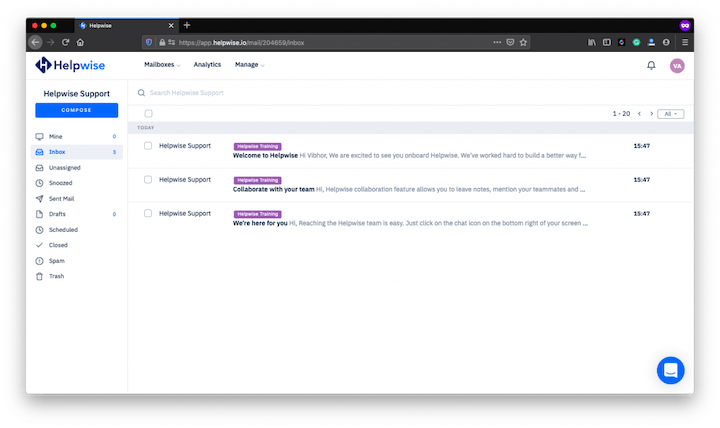
Helpwise is a great option for teams that interact heavily with customers through messaging platforms like SMS, Line, WeChat, or WhatsApp and social sites such as Twitter or Facebook. It acts as a hub for all those platforms, helping to limit missed messages and confusion among your team.
Price: Starting at $20/user per month.
8. Kayako
Best shared email account tool for social media support.

While it is a full support platform, Kayako’s shared inbox tool focuses on unifying your customers’ interactions across email, Facebook, Twitter, and live chat channels while keeping all of the conversations organized and accessible through customizable features like tags.
Integrations with other tools and features like internal notes and collision detection are offered, although they are limited to their top-tier plans.
Price: Starting at $30/agent per month.
9. ClientFlow
Best shared inbox for project management.
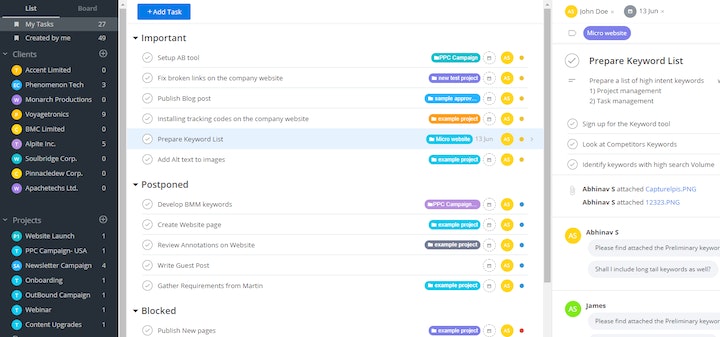
For those looking for a project management feature outside of the Gmail realm, ClientFlow may be a good alternative. ClientFlow was created for service teams and is an all-in-one tool for managing client communication and current projects.
By combining a shared inbox with a project management tool, there’s less siloed data and more transparency in your agents’ tasks, helping with overall efficiency.
Price: Starting at $19/user per month.
3 different ways to create a shared email account
The power of simple yet efficient email is incredible and can determine the quality of your customer support. However, when multiple people are trying to read, manage, and reply to customer conversations, things can quickly spiral.
Team email management tools have become crucial for the success of email customer service. There are several types of tools that allow access and management of a shared email, and of course, each option has advantages and limitations.
Below are three of the most common forms of shared email accounts between teams.
Distribution list
A distribution list is used to send emails to groups of people without having to enter each recipient's email address one by one.
The pro of this is the ease with which an email can go out to a large number of people. The main con of a distribution list is twofold: A subscriber can’t directly respond to the email on their end, and employees cannot see whether their coworkers have already responded to the initial inquiry or what they suggested.
Out of the three options for addressing emails, distribution lists are the most limited in terms of scale. They are an excellent email sharing option for teams just starting out, but they aren’t as robust for teams working on email for the long term.
Shared mailbox
If you only need to work from a single queue and have no need for additional collaboration, reporting, and productivity features, a shared mailbox may be the best option for you.
A shared mailbox is a hub where multiple users can read and send emails. They can also provide a shared calendar and thereby allow users to schedule and view vacation time or shifts. Shared mailboxes reinforce a perception of trust and transparency.
Working in real time with colleagues is a huge benefit to using a shared inbox or a shared mailbox. When offering support, being able to pivot quickly and work collaboratively on an issue can be the difference between a stellar customer experience and a mediocre one. Real-time email sharing also allows viewers to see what is currently being worked on and prevents your team from wasting their time and effort on an issue that’s already being resolved.
The largest shortcoming of a shared mailbox, however, is that it can become crowded, leading to tasks being interrupted or users being forced to wait for access.
Shared inbox
A shared inbox offers the most advanced team collaboration features and lends itself best to scaling. Shared inboxes allow members to view reports, adjust permissions and account settings, see historical customer data, add private notes, and — perhaps the greatest advantage over the other options — prevent duplicate replies.
Team inboxes are beneficial for any customer-facing team. Customer success, customer support, sales — even marketing in some cases — are an incredibly powerful way for teams to work together and create the best response possible in the quickest amount of time.
The customer’s end experience is not impacted when one of your team members uses a shared inbox. For most tools, there is no difference in an email written and sent from an individual email account versus a team inbox — if done well, they should look the same. While customers may realize that a company is email sharing when they receive multiple responses from the same email address signed with different names, they should never feel that service is disrupted by team members sharing an inbox.
How to choose the option that's right for your team
Buying support software at any stage in your business’s growth can be a large undertaking and a stressful experience. Choosing the right option for your team comes down to deciding which features you need in order to deliver exceptional customer service. It’s also important to think beyond what your team needs right now and consider what needs you might have as your business grows.
Before committing to anything, do your best to fully understand what your team needs:
Where do you interact with your customers most, and how is that channel changing over time?
Where in the customer journey do your customers need the most help?
What issues are most frequent for your team (organization, siloed processes, etc.)?
Take advantage of free trials if you’re unsure or just want to compare options. If you make sure to keep an open mind, seek diverse opinions, and adjust your expectations accordingly, we’re confident you’ll end up with a great option for your team.
Choose a tool that will grow with you
Choosing the right option for your team comes down to deciding which features you need in order to deliver exceptional customer service. It’s also important to think beyond what your team needs right now and consider what needs you might have as your business grows.













